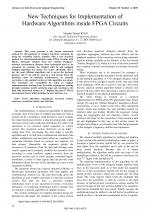| 2/2010 - 3 |
New Techniques for Implementation of Hardware Algorithms inside FPGA CircuitsIOAN, A. D. |
| Extra paper information in |
| Click to see author's profile in |
| Download PDF |
Author keywords
algorithm organigram, execution section, sequencer, transition matrix, user interface
References keywords
fpga(7), design(7), link(5), xilinx(4)
Blue keywords are present in both the references section and the paper title.
About this article
Date of Publication: 2010-05-31
Volume 10, Issue 2, Year 2010, On page(s): 16 - 23
ISSN: 1582-7445, e-ISSN: 1844-7600
Digital Object Identifier: 10.4316/AECE.2010.02003
Web of Science Accession Number: 000280312600003
SCOPUS ID: 77954626692
Abstract
This work presents a less known theoretical method for the synthesis of complex hardware automata by using the transition matrix, together with a new practical method for visual implementation inside FPGA circuits, with library schematic symbols from the Altium Designer software environment. Because these techniques need to be presented by example, the classical shift and add unsigned multiply algorithm was chosen for review. Obviously, this is not the most efficient algorithm, but it serves the declared purpose and it can still be used in a real system when the hardware must be minimal. Furthermore, an essential correction to the optimal version of this algorithm was made. The techniques are exemplified by doing an original implementation: starting from the initial organigram, passing through transition matrix synthesis stage and reaching to the final fully functional system on a Digilent Spartan-3 FPGA development board, which includes the user interface too. |
| References | | | Cited By «-- Click to see who has cited this paper |
| [1] D. A. Patterson, J. L. Hennessy, "Computer Organization and Design. The Hardware / Software Interface", 4th edition, Morgan Kaufmann Publishers - Elsevier, 2009. [PermaLink]
[2] M. Morris Mano, Charles R. Kime, "Logic and Computer Design Fundamentals", 3rd edition, Prentice Hall, 2004. [PermaLink] [3] ***, Training Manual, "Altium Designer. FPGA Design Basics", Altium Limited, 2008, Available: Temporary on-line reference link removed - see the PDF document [4] J. P. Hayes, "Computer Architecture and Organization", 3rd edition, McGraw-Hill, 2002. [5] C. Maxfield, "FPGAs World Class Designs", Newnes, Elsevier, 2009. [PermaLink] [6] S. Brown, J. Rose, "FPGA and CPLD architectures: a tutorial", IEEE Design & Test of Computers, Vol. 13, No. 2, IEEE Computer Society, 1996. [CrossRef] [Web of Science Times Cited 166] [SCOPUS Times Cited 245] [7] J. J. Rodrigues-Andina, M. J. Moure, M. D. Valdes, "Features, Design Tools, and Application Domains of FPGAs", IEEE Transactions on Industrial Electronics, Vol. 54, No. 4, IEEE Industrial Electronics Society, 2007. [CrossRef] [Web of Science Times Cited 278] [SCOPUS Times Cited 344] [8] S. Kilts, "Advanced FPGA Design. Architecture, Implementation and Optimization", John Wiley & Sons, Inc., 2007. [PermaLink] [9] P. P. Chu, "FPGA Prototyping by Verilog Examples, Xilinx Spartan-3 Version", John Wiley & Sons, Inc., 2008. [CrossRef] [SCOPUS Times Cited 110] [10] ***, Tutorial, "Xilinx ISE 9.1 In-Depth", Xilinx Inc., 2007, Available: Temporary on-line reference link removed - see the PDF document [11] Z. Navabi, "Digital Design and Implementation with Field Programmable Devices", Kluwer Academic Publishers, 2005. [CrossRef] [12] A. D. Ioan, "Designing the Synchro-Generator of an FPGA or CPLD Video Interface for Micro-Systems", International Conference on Development and Application Systems, Suceava, Romania, 2008. [13] ***, Core Reference, "FPGA Generic Library Guide", Altium Limited, 2005, Available: Temporary on-line reference link removed - see the PDF document [14] ***, Complete Data Sheet, "Spartan - 3 1.2 V FPGA family", Xilinx Inc., 2008, Available: Temporary on-line reference link removed - see the PDF document [15] ***, User Guide, "Spartan-3 Starter Kit Board", Digilent Inc., 2005, Available: Temporary on-line reference link removed - see the PDF document Web of Science® Citations for all references: 444 TCR SCOPUS® Citations for all references: 699 TCR Web of Science® Average Citations per reference: 30 ACR SCOPUS® Average Citations per reference: 47 ACR TCR = Total Citations for References / ACR = Average Citations per Reference We introduced in 2010 - for the first time in scientific publishing, the term "References Weight", as a quantitative indication of the quality ... Read more Citations for references updated on 2025-05-28 16:02 in 29 seconds. Note1: Web of Science® is a registered trademark of Clarivate Analytics. Note2: SCOPUS® is a registered trademark of Elsevier B.V. Disclaimer: All queries to the respective databases were made by using the DOI record of every reference (where available). Due to technical problems beyond our control, the information is not always accurate. Please use the CrossRef link to visit the respective publisher site. |
Faculty of Electrical Engineering and Computer Science
Stefan cel Mare University of Suceava, Romania
All rights reserved: Advances in Electrical and Computer Engineering is a registered trademark of the Stefan cel Mare University of Suceava. No part of this publication may be reproduced, stored in a retrieval system, photocopied, recorded or archived, without the written permission from the Editor. When authors submit their papers for publication, they agree that the copyright for their article be transferred to the Faculty of Electrical Engineering and Computer Science, Stefan cel Mare University of Suceava, Romania, if and only if the articles are accepted for publication. The copyright covers the exclusive rights to reproduce and distribute the article, including reprints and translations.
Permission for other use: The copyright owner's consent does not extend to copying for general distribution, for promotion, for creating new works, or for resale. Specific written permission must be obtained from the Editor for such copying. Direct linking to files hosted on this website is strictly prohibited.
Disclaimer: Whilst every effort is made by the publishers and editorial board to see that no inaccurate or misleading data, opinions or statements appear in this journal, they wish to make it clear that all information and opinions formulated in the articles, as well as linguistic accuracy, are the sole responsibility of the author.



